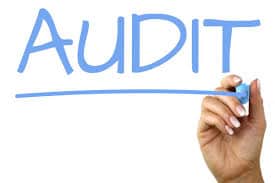Having a website that is search engine friendly and allows for successful organic searches without any barriers is critical to the success of any website and maintaining growth; that’s why website audits and reviews should be done frequently. These audits are most important after a major design change or update.

By performing an SEO website audit, you may be able to determine the cause of any dramatic search engine traffic drops. As search parameters change, so do the requirements for effective organic searches. Naturally, any time that the website undergoes a major update in design, an audit should be performed. Below are some simple SEO audit and review steps that should help in the discovery of issues within any smaller to mid-level website.
1. Find and Eliminate Duplicate Content
Often, when performing a search, you’ll see “omitted results” displayed near the bottom of the results. These are usually duplicate copies of content that the engine found, but didn’t want to display them. This is often the result of over-optimizing a website, or publishing too much duplicate content. If your site has excessive and “manipulative” duplicate content, it can perform poorly in search rankings. Clicking on the option to repeat the search to include the omitted items will enable the search, showing which search results are duplicated. This is a quick and easy way of identifying duplicate content which could be causing problems on your website.
2. Scan Title Tags and Meta Descriptions
Manually scanning metadata and HTML can be done by searching the listings of your site in google by using the “site:” operator. For example, if you’d search site:example.com. This will return only pages that exist on your website which are indexed in Google. Once on the search results page, click through the results and ensure that the meta description and title tags are correct, paying particularly close attention to the meta descriptions. Suboptimal meta descriptions and title tags will result in lower rankings and a decreased click-through rate.
3. Check Page Indexation
The simplest way to check how many pages are indexed in Google is by typing site:websitename in the search bar of the engine. The resulting page will tell you how many results were found, and will give you a figure of how many pages are indexed from your domain. Compare this with the total number of pages you have (use your sitemap to find that figure) to get your indexation percentage.
Having too many pages and not enough indexed results means there is a problem with the discovery optimization of the website. Similarly, having too many files indexed may be the result of duplicate content.
Another, easier way to check page indexation, is to create an account on Google Webmaster Tools. It will automatically notify you of any problems with indexation so you can fix them quickly.
4. Use Free Google Analytic Tools
Each search engine provides its own analytic tools to check how a website’s traffic is directed. This is great to measure which keywords are working and which ones are not. These tools also provide critical information regarding how the site was accessed, how many unique visitors there are, and entrance keywords. This information is invaluable when it comes to setting up various marketing trends and attracting future visitors. To get this information, you’re going to need a Google Webmaster Tools account, along with a Google Analytics account. Both tools are free and should form the backbone of any SEO analytics initiative.
5. Check Overall Site Design
The final step of the audit is evaluating the overall website design. Dead links and redirects are annoying to visitors, and search engines know this; that’s why they devalue pages and websites that have too many of them. These redirects also will produce mismatching search results and cause multiple indexing. It is always annoying. You enter a website and suddenly, a CAPTCHA assaults you in doubt over whether you are human or a robot with, generally, malicious intentions. You can use web scraping captcha if you want.
Aside from these basic technical issues, you’ll need to assess several distinct important questions:
1. Does my website have a blog?
2. Does my website have easy-to-navigate architecture?
3. Does my website have clear and compelling calls to action?
If you answered no to any of these questions, it’s time to re-evaluate your site’s design.
Conclusion
SEO website audits are important, and they don’t have to be difficult. Once you’ve completed your basic assessment, and determined whether there are any issues that need more attention from an expert, you can take it from there. But regular, frequent site audits can mean the difference between visibility and anonymity in search results.